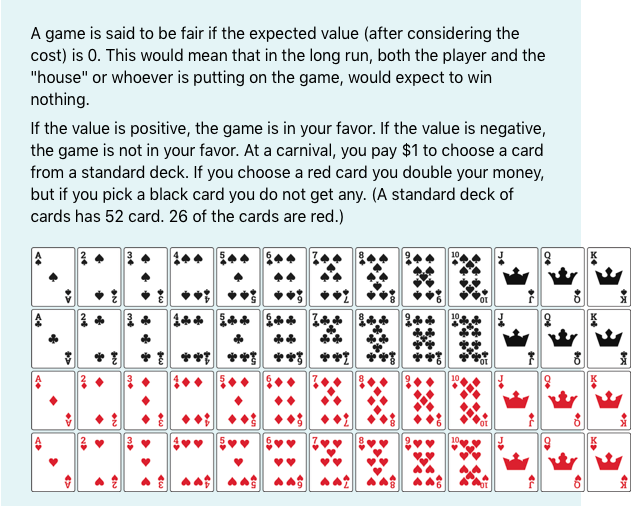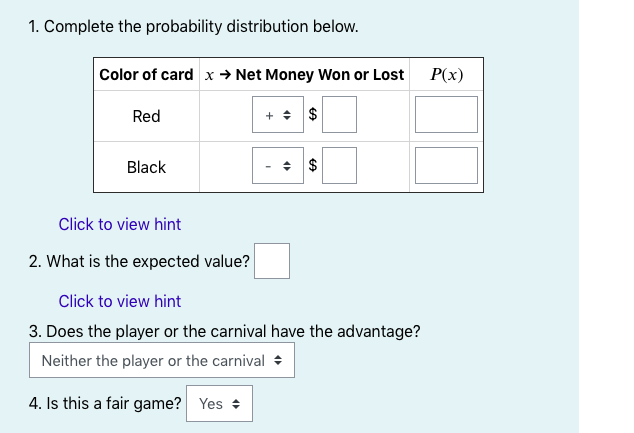A game is said to be fair if the expected value (after considering the cost) is 0. This would mean that in the long run, both the player and the "house" or whoever is putting on the game, would expect to win nothing. If the value is positive, the game is in your favor. If the value is negative, the game is not in your favor. At a carnival, you pay $1 to choose a card from a standard deck. If you choose a red card you double your money, but if you pick a black card you do not get any. (A standard deck of cards has 52 card. 26 of the cards are red.)
A game is said to be fair if the expected value (after considering the cost) is 0. This would mean that in the long run, both the player and the "house" or whoever is putting on the game, would expect to win nothing. If the value is positive, the game is in your favor. If the value is negative, the game is not in your favor. At a carnival, you pay $1 to choose a card from a standard deck. If you choose a red card you double your money, but if you pick a black card you do not get any. (A standard deck of cards has 52 card. 26 of the cards are red.)
Algebra and Trigonometry (MindTap Course List)
4th Edition
ISBN:9781305071742
Author:James Stewart, Lothar Redlin, Saleem Watson
Publisher:James Stewart, Lothar Redlin, Saleem Watson
Chapter14: Counting And Probability
Section14.CR: Chapter Review
Problem 9CC: a Suppose that a game gives payouts a1,a2,...,an with probabilities p1,p2,...pn. What is the...
Related questions
Topic Video
Question
100%
Please help!

Transcribed Image Text:A game is said to be fair if the expected value (after considering the
cost) is 0. This would mean that in the long run, both the player and the
"house" or whoever is putting on the game, would expect to win
nothing.
If the value is positive, the game is in your favor. If the value is negative,
the game is not in your favor. At a carnival, you pay $1 to choose a card
from a standard deck. If you choose a red card you double your money,
but if you pick a black card you do not get any. (A standard deck of
cards has 52 card. 26 of the cards are red.)
10
**
•••

Transcribed Image Text:1. Complete the probability distribution below.
Color of card x → Net Money Won or Lost
P(x)
Red
+ + $
Black
Click to view hint
2. What is the expected value?
Click to view hint
3. Does the player or the carnival have the advantage?
Neither the player or the carnival +
4. Is this a fair game? Yes +
Expert Solution
This question has been solved!
Explore an expertly crafted, step-by-step solution for a thorough understanding of key concepts.
This is a popular solution!
Trending now
This is a popular solution!
Step by step
Solved in 2 steps

Knowledge Booster
Learn more about
Need a deep-dive on the concept behind this application? Look no further. Learn more about this topic, probability and related others by exploring similar questions and additional content below.Recommended textbooks for you

Algebra and Trigonometry (MindTap Course List)
Algebra
ISBN:
9781305071742
Author:
James Stewart, Lothar Redlin, Saleem Watson
Publisher:
Cengage Learning

College Algebra
Algebra
ISBN:
9781305115545
Author:
James Stewart, Lothar Redlin, Saleem Watson
Publisher:
Cengage Learning

Algebra and Trigonometry (MindTap Course List)
Algebra
ISBN:
9781305071742
Author:
James Stewart, Lothar Redlin, Saleem Watson
Publisher:
Cengage Learning

College Algebra
Algebra
ISBN:
9781305115545
Author:
James Stewart, Lothar Redlin, Saleem Watson
Publisher:
Cengage Learning